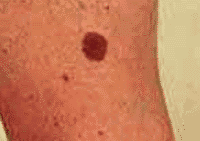
Moles can appear anywhere on the skin, alone or in groups. They are usually brown in colour and can be various sizes and shapes. The brown color is caused by melanocytes, special cells that produce the pigment melanin. Moles probably are determined before a person is born. Most appear during the first 20 years of a person's life, although some may not appear until later in life.

Sun exposure increases the number of moles. Each mole has its own growth pattern. At first, moles are flat and tan, pink, brown or black in color, like a freckle. Over time, they usually enlarge and some develop hairs. As the years pass, moles usually change slowly, becoming more raised and lighter in color. Some will not change at all. Most moles will slowly disappear, seeming to fade away. Others will become raised so far from the skin that they may develop a small "stalk" and eventually fall off or are rubbed off. This is the typical life cycle of the common mole.

These changes occur slowly since the life cycle of the average mole is about 50 years. Moles may darken, with exposure to the sun. During the teen years, with birth control pills and pregnancy, moles often get darker and larger and new ones may appear.